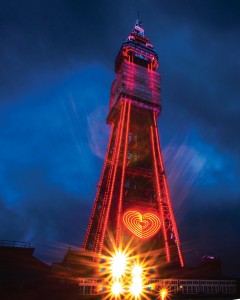The Blackpool Tower Takes LED Lighting To New Heights
Posted by Mark Atkinson on 24th Jun 2016

One of Britain’s best-loved, historical tourist attractions, having stood proud for over a century, is now using stunning, eco-friendly LEDs for illumination!
Opened to the public in 1894, the Blackpool Tower has been drawing crowds since before the end of Queen Victoria’s reign, and at 518 feet tall, it can be seen for miles around.
In 2002, the tower began its transition from the 100,000 incandescent pygmy bulbs which had traditionally provided its light, to the fantastic display which incorporates 5,508 colour-changing LED lights that it boasts today.
For a fee, star-crossed lovers can spell out their names in lights, for all the world to see.
Eco-Friendly
This big switch represents a huge investment for Blackpool Council, not just in the future of the tower itself, but also in its commitment to making both the landmark and the resort’s world-famous Illuminations completely neutral as far as carbon emissions are concerned.
Wind turbines, hydro-electric power and bio-gas, which is produced from the anaerobic fermentation of carbohydrates in plant material or waste, have all been implemented to augment the revolutionary LED technology’s incredible energy-saving abilities, thus reducing the annual Illuminations carbon emissions to zero, a saving of 420 tonnes per year.
The aforementioned pygmy bulbs were incredibly wasteful, requiring a high number of watts to power them in comparison to the up-to-date LEDs, and producing only a small amount of light in return.
Energy-Savers = Money-Savers
Thus a 25 watt pygmy incandescent bulb will produce 180 Lumens of brightness, whereas a similarly bright LED bulb will require just 3 watts of power.
The savings the council made by switching to LED were nothing short of phenomenal, and to put them into perspective:
- Each 25 watt pygmy bulb uses 0.25 kW/h (kilowatts per hour) which extrapolates to 912.5 kW/h per year, if it’s assumed that they were burning for 10 hours a day.
- Therefore, also assuming that the electricity provider for the tower charges 15 pence per kilowatt, the price to run one bulb for a year would be £136.87.
- Now multiply that by the number of incandescent bulbs (100,000), and the cost to light the tower for a year was a staggering £13,687,500.
Compare this figure to the cost of the LED bulb:
- The 3 watt LED bulb generates just 0.03 kW/h which equates to 109.5 kW/h per year, at a similar daily usage.
- Thus each bulb would cost £16.42 per year to run.
- Extrapolating to the 5,508 LEDs that replaced the tower’s original pygmy bulbs, this would incur an electricity cost of £90,468.
Whilst this is still a considerable amount of money, it represents a saving of over £13 million pounds every year, and is a drop in the North Sea by comparison!
Coupled with this massive energy saving is the fact that the new LED bulbs, like the ones that we sell, have an average life-expectancy of over 50,000 hours, in comparison with that of the traditional pygmy incandescent bulbs, which at just 1000 hours, would need changing roughly 8 times a year.
Changing a light bulb that’s half way up Blackpool Tower is not like changing one in your living room. It’s expensive in terms of both maintenance costs and man-hours, so it’s a very good job that the LEDs will continue to illuminate the promenade for more than 17 years to come!
Successful Outcomes
Following the huge success of the tower and illuminations projects, Blackpool Council, are working in partnership with the community to save residents and businesses money on their energy bills. In a project known as “Ready to Switch?” the local populace is being encouraged to embrace a more economical approach to energy, including switching to LED lighting.
Since the scheme was launched, more than 35,000 households have signed up and made positive changes to their energy bills, and Blackpool Tower’s 5,508 LED bulbs turned green in support of the scheme.
Kate Shane, Blackpool Tower General Manager, said: “[The] Tower is happy to be involved to raise awareness of the “Ready to Switch?” initiative. Blackpool Tower Illumination changed from the old style lighting to more energy efficient LED lighting which significantly reduced energy consumption and offered fantastic improvements in lighting colour and movement capabilities.”
Not a bad result for a humble LED light bulb!
Photograph courtesy of Jay Aheer





